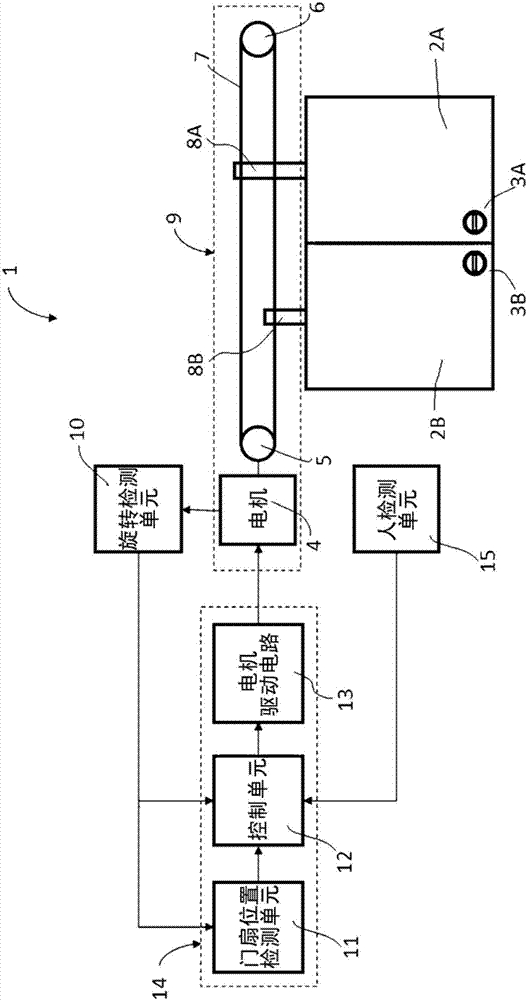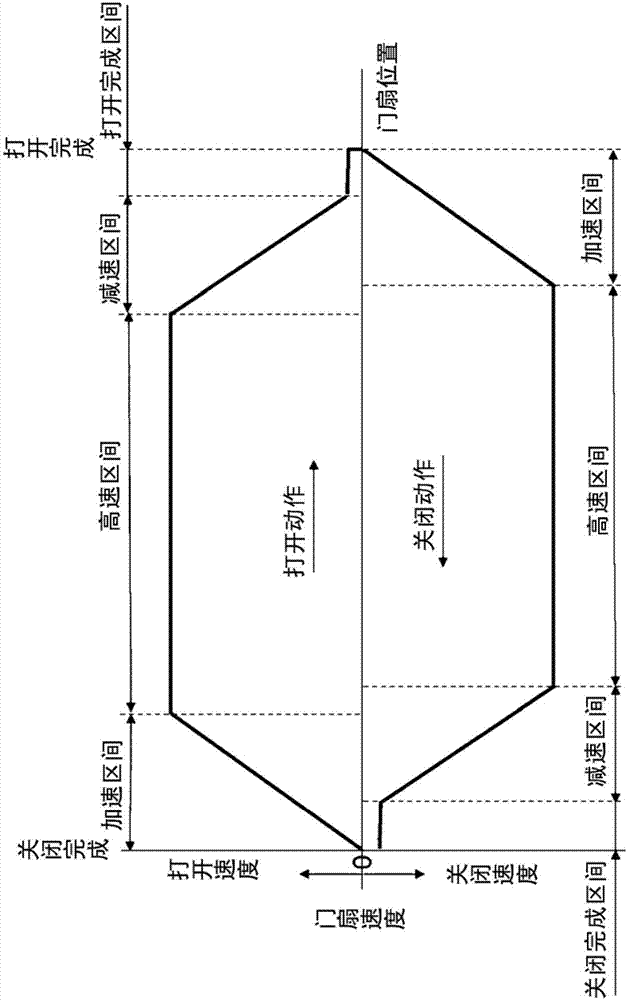Automatic door and control method thereof
A control method and automatic door technology, which is applied to door/window accessories, power control mechanisms, wing leaf control mechanisms, etc., can solve problems such as door leaf movement obstruction, and achieve the effect of easy concession and injury prevention
- Summary
- Abstract
- Description
- Claims
- Application Information
AI Technical Summary
Problems solved by technology
Method used
Image
Examples
no. 1 approach
[0061] figure 1 It is a block diagram illustrating the outline of the automatic door 1 according to Embodiment 1 of the present invention. A driving pulley 5 is attached to the motor 4 via a speed reducer (not shown), and a belt 7 is stretched between the driving pulley 6 and the driven pulley 6 . The doors 2A, 2B are connected to the belt 7 via the belt clamps 8A, 8B provided on the upper parts thereof, move in the opening direction by forward rotation of the motor 4 , and move in the closing direction by reverse rotation. A driving unit 9 for an automatic door including a motor 4, a driving pulley 5, a driven pulley 6, a belt 7, and the like is disposed above the door leaves 2A, 2B.
[0062] In addition, locking means 3A, 3B constituted by pin locks are attached to the lower parts of the doors 2A, 2B so that the doors 2A, 2B can be locked or unlocked.
[0063] The automatic door is connected with a person detection unit 15 that detects a person passing through the doors 2A...
no. 2 approach
[0135] Since Embodiment 2 is only available in Figure 7 The shown abnormality detection part of the finger-trap avoidance program differs from the first embodiment, so only the different configuration will be described, and other configurations are the same as those in the first embodiment, so descriptions will be omitted.
[0136] Figure 9 It is a flow chart of the finger pinching avoidance program at the time of abnormality detection in Embodiment 2. exist Figure 7 In the case where the abnormality detection position during the opening operation is within a predetermined range from the closing completion position (step 5), transfer to Figure 9 The finger pinch avoidance procedure during anomaly detection (inside the dotted box). As finger pinching avoidance processing, control unit 12 makes the driving current of the opening direction of motor 4 gradually reduce to substantially zero (step 31) through predetermined time, then, wait for the stop of motor, confirm the s...
no. 3 approach
[0141] Since Embodiment 3 is only available in Figure 7 The shown abnormality detection differs from Embodiment 1 in that a part of the finger-trap avoidance program is different, so only the different configuration will be described, and other configurations are the same as those in Embodiment 1, so descriptions will be omitted.
[0142] Figure 10 It is a flow chart of the finger pinching avoidance program at the time of abnormality detection in Embodiment 3. exist Figure 7 In the case where the abnormality detection position during the opening operation is within a predetermined range from the closing completion position (step 5), transfer to Figure 10 The finger pinch avoidance procedure during anomaly detection (inside the dotted box). Control unit 12 judges whether the position of the door leaf after the predetermined time standby from the abnormality detection is within the predetermined range from the position of the door leaf during the abnormality detection (st...
PUM
 Login to View More
Login to View More Abstract
Description
Claims
Application Information
 Login to View More
Login to View More - R&D
- Intellectual Property
- Life Sciences
- Materials
- Tech Scout
- Unparalleled Data Quality
- Higher Quality Content
- 60% Fewer Hallucinations
Browse by: Latest US Patents, China's latest patents, Technical Efficacy Thesaurus, Application Domain, Technology Topic, Popular Technical Reports.
© 2025 PatSnap. All rights reserved.Legal|Privacy policy|Modern Slavery Act Transparency Statement|Sitemap|About US| Contact US: help@patsnap.com



